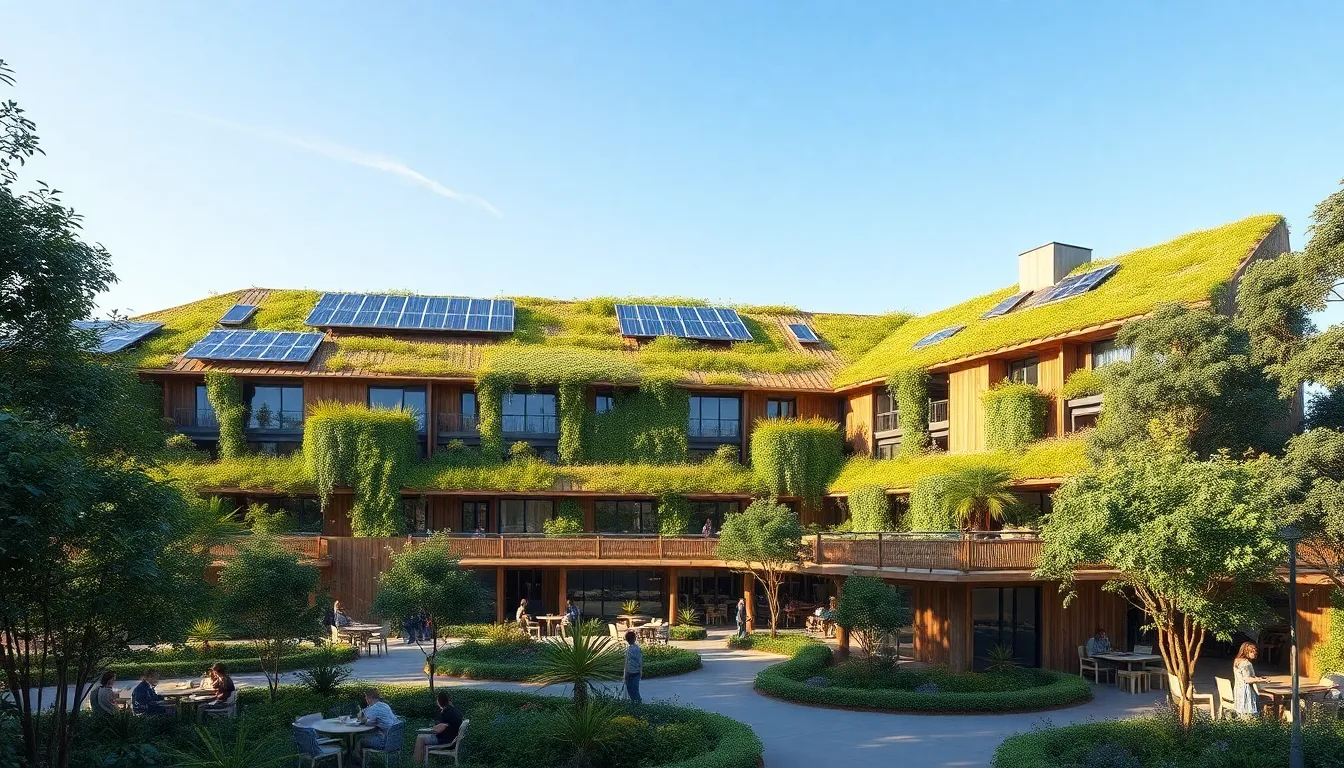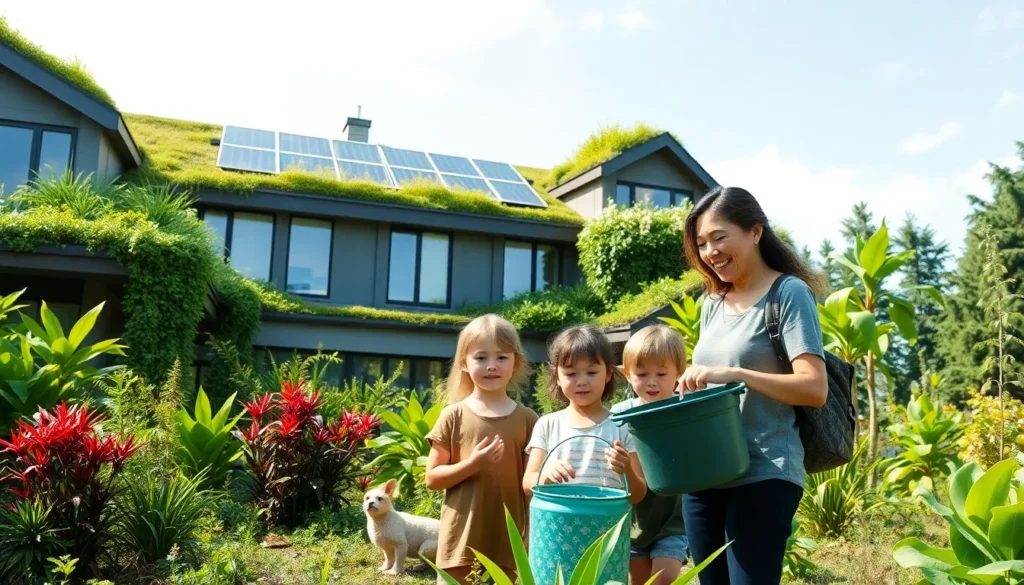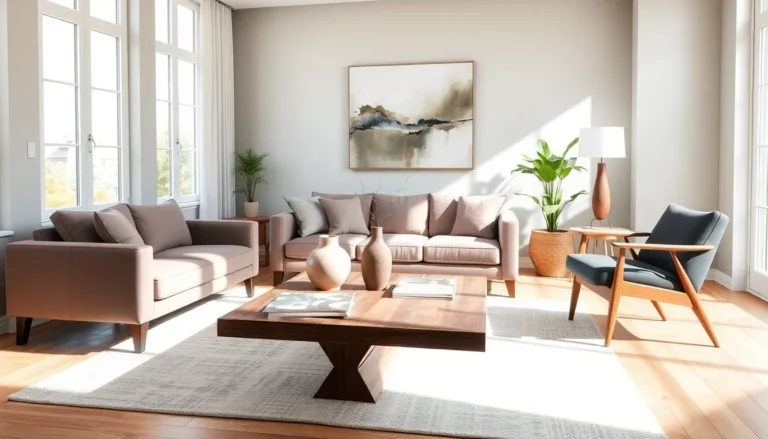Imagine a building so green it makes your houseplant look like a slacker. Welcome to the most sustainable living building on Earth, a marvel that redefines eco-friendly architecture. This isn’t just a structure; it’s a living, breathing ecosystem designed to harmonize with nature while providing cutting-edge comfort.
From solar panels that practically high-five the sun to walls that purify air better than your favorite air freshener, this building takes sustainability to a whole new level. It’s like Mother Nature herself decided to throw a party, and everyone’s invited. Get ready to dive into the details of this architectural wonder that proves living sustainably doesn’t mean sacrificing style or comfort. After all, who said saving the planet couldn’t be a little fun?
Table of Contents
ToggleOverview Of Sustainable Architecture
Sustainable architecture focuses on designing buildings that minimize environmental impact while promoting the health and well-being of occupants. It incorporates energy-efficient technologies and materials that reduce waste, conserve resources, and promote a healthier lifestyle.
Key components include the use of renewable energy sources like solar power, wind energy, and geothermal systems. By integrating these technologies, architects create structures that not only reduce reliance on fossil fuels but also lower utility costs for residents.
Water conservation plays a significant role in sustainable architecture. Rainwater harvesting systems and greywater recycling can significantly decrease water waste. These methods help alleviate pressure on municipal water sources and improve local ecosystems.
Another essential aspect involves utilizing sustainable materials, such as bamboo, reclaimed wood, and recycled steel. These materials offer durability while minimizing ecological footprints. Many modern buildings are designed to include natural light, enhancing indoor air quality and reducing the need for artificial lighting.
Landscaping also contributes to sustainability. Green roofs, native plants, and permeable surfaces help manage stormwater, lower heat absorption, and support biodiversity. Incorporating natural elements encourages a harmonious relationship between the building and its surroundings.
Lastly, sustainable architecture promotes community engagement by prioritizing accessibility and inclusivity. Spaces designed for social interaction can strengthen relationships among residents and foster a sense of belonging. Implementing these principles leads to a more sustainable future while enhancing the quality of life for all individuals involved.
The Most Sustainable Living Building On Earth

This living building sets a benchmark in sustainable architecture through its innovative features and eco-friendly practices. Every element was designed to harmonize with the environment while maintaining a high standard of comfort.
Features That Define Sustainability
Innovative technology plays a crucial role in sustainability. Solar panels generate renewable energy, significantly reducing the building’s carbon footprint. Green roofs improve insulation while fostering biodiversity by providing habitats for various species. Dynamic air-purifying walls filter pollutants, ensuring clean indoor air quality. Water conservation systems utilize rainwater harvesting and greywater recycling, minimizing waste and promoting resource efficiency. Effective natural light incorporation reduces reliance on artificial lighting, resulting in lower energy consumption. Engaging communal spaces foster social connections among residents, enhancing community well-being.
Materials Used In Construction
Selecting materials significantly impacts the building’s sustainability. Reclaimed wood provides a unique aesthetic while reducing deforestation. Bamboo, known for its rapid growth and strength, offers an eco-friendly building alternative. Insulating materials come from recycled sources, enhancing energy efficiency. Non-toxic paints and finishes contribute to healthier indoor environments. High-performance glass minimizes energy loss and supports passive heating and cooling. Local sourcing of materials decreases transportation emissions, supporting regional economies. Each choice reflects a commitment to minimizing environmental impact during construction.
Impact On Environment
This sustainable living building significantly benefits the environment through its innovative practices. The design prioritizes minimizing ecological damage while enhancing the resident experience.
Energy Efficiency
Energy efficiency plays a central role in this building’s environmental impact. Solar panels generate renewable electricity, meeting a substantial portion of the energy demands. Utilization of smart technologies allows for optimized energy usage, reducing waste and lowering utility costs. The structure features high-performance insulation that cuts energy loss, maintaining a comfortable interior climate with minimal heating and cooling requirements. Moreover, energy-efficient appliances contribute to overall sustainability by consuming less power while providing modern conveniences.
Water Conservation
Water conservation is another critical feature of this architectural marvel. Rainwater harvesting systems collect precipitation for irrigation and graywater usage, significantly reducing the demand on local water supplies. Innovative fixtures like low-flow faucets and dual-flush toilets minimize water consumption, ensuring every drop is used efficiently. The green roofs also aid in water management by absorbing rainwater, decreasing runoff and promoting local biodiversity. Overall, these practices not only conserve water but also demonstrate a commitment to sustainable living.
Community Benefits
This sustainable living building positively influences the surrounding community in various ways, enhancing both social cohesion and economic vitality.
Social Responsibility
Sustainable architecture promotes inclusivity and social engagement among residents. Developing community spaces fosters interactions, creating a sense of belonging. Programs that involve local artists and businesses help strengthen community ties. Educational workshops focus on sustainable living practices, empowering residents with knowledge and skills. Such initiatives contribute to a vibrant community, encouraging collective responsibility for environmental stewardship.
Economic Impacts
Economic benefits arise from this innovative structure, influencing local business growth and job creation. Decreased energy costs lead to financial savings for residents, allowing for greater disposable income. Nearby businesses experience increased foot traffic due to community engagement activities and events hosted in the building. Additionally, the building attracts eco-conscious investors, fostering sustainable development in the area. Overall, this project demonstrates that sustainability can drive economic prosperity while benefiting the environment.
This groundbreaking living building stands as a testament to what sustainable architecture can achieve. By harmonizing modern design with eco-friendly practices it not only redefines the concept of a green structure but also enhances community well-being. The integration of renewable energy sources and innovative water conservation methods showcases a commitment to reducing environmental impact while promoting a healthier lifestyle.
As this project inspires future developments it emphasizes the importance of community engagement and inclusivity. It proves that sustainable living can foster economic growth and social cohesion. This remarkable achievement invites everyone to rethink how buildings can contribute positively to both people and the planet.






